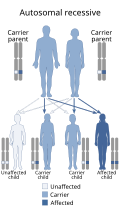Lan blood group system
| ABCB6 (Lan blood group antigen; LAN1) | |||||||
|---|---|---|---|---|---|---|---|
| Identifiers | |||||||
| Symbol | ABCB6 | ||||||
| NCBI gene | 10058 | ||||||
| HGNC | 47 | ||||||
| OMIM | 111600 | ||||||
| UniProt | Q9NP58 | ||||||
| Other data | |||||||
| Locus | Chr. 2 q36 | ||||||
| |||||||
The Lan blood group system (short for Langereis) is a human blood group defined by the presence or absence of the Lan antigen on a person's red blood cells. More than 99.9% of people are positive for the Lan antigen. Individuals with the rare Lan-negative blood type, which is a recessive trait, can produce an anti-Lan antibody when exposed to Lan-positive blood. Anti-Lan antibodies may cause transfusion reactions on subsequent exposures to Lan-positive blood, and have also been implicated in mild cases of hemolytic disease of the newborn. However, the clinical significance of the antibody is variable. The antigen was first described in 1961, and Lan was officially designated a blood group in 2012.[1][2]
Molecular biology

The Lan antigen is carried on the protein ABCB6, an ATP-binding cassette transporter encoded by the ABCB6 gene on chromosome 2q36. The Lan-negative blood type is inherited in an autosomal recessive manner, being expressed by individuals who are homozygous for nonfunctional alleles of ABCB6.[1][2] Some variant alleles cause a weak positive phenotype, which may be mistaken for a Lan-negative phenotype in serologic testing.[2] As of 2018, more than 40 null or weak alleles of ABCB6 have been described.[3]
ABCB6 is involved in heme synthesis and porphyrin transport and is widely expressed throughout the body, particularly in the heart, skeletal muscle, eye, fetal liver, mitochondrial membrane, and Golgi bodies.[4]: 220 The Lan antigen is more strongly expressed on cord blood cells than on adult red blood cells.[5]: 490 Despite the protein's wide distribution, Lan-negative individuals do not appear to experience any adverse effects from the absence of ABCB6.[1][2] It is thought that other porphyrin transporters, such as ABCG2 (which carries the Junior blood group antigen), may compensate.[4]: 220 [6] A 2018 study found that Lan-negative blood cells exhibited resistance to Plasmodium falciparum in vitro.[7]
Epidemiology
The prevalence of the Lan antigen exceeds 99.9% in most populations. The frequency of the Lan-negative blood type is estimated at 1 in 50,000 in Japanese populations, 1 in 20,000 in Caucasians, and 1 in 1,500 in black people from South Africa.[2]
Clinical significance
When Lan-negative individuals are exposed to Lan-positive blood through transfusion or pregnancy, they may develop an anti-Lan antibody. Anti-Lan is considered a clinically significant antibody,[4]: 220 but its effects are variable. It has been associated with severe transfusion reactions and mild cases of hemolytic disease of the newborn, but in some cases individuals with the antibody have not experienced any adverse effects from exposure to Lan-positive blood. It is recommended that individuals with anti-Lan are transfused with Lan-negative blood, especially if the antibody titer is high.[2] One case of autoimmune hemolytic anemia involving auto-anti-Lan has been described.[2]
Laboratory testing
Serologic reagents and molecular assays for Lan antigen typing were not commercially available as of 2013.[2]
Anti-Lan antibodies are typically composed of immunoglobulin G and may bind complement. As an IgG antibody, anti-Lan can be detected using the indirect antiglobulin test. The antibody is resistant to treatment with ficin, papain, trypsin, DTT, and EDTA/glycine-acid.[2][4]: 220
History
The Lan antigen was first described in 1961 by Van der Hart et al.,[8] when a Dutch patient suffered a severe hemolytic transfusion reaction.[4]: 220 [5]: 489 The patient was found to produce an antibody that reacted with all but 1 out of 4,000 blood donors tested. The causative antigen was identified and designated "Langereis" after the patient's last name.[2] Lan was officially designated a blood group by the International Society of Blood Transfusion in 2012, following the discovery of the molecular basis of the Lan-negative phenotype.[4]: 220 [9][10]
References
- ^ a b c Bocchini CA (2015). "#111600 - BLOOD GROUP, LANGEREIS SYSTEM; LAN". Online Mendelian Inheritance in Man. Retrieved 16 May 2020.
- ^ a b c d e f g h i j Peyrard T (2019). "The LAN blood group system:a review" (PDF). Immunohematology. 29 (4): 131–5. doi:10.21307/immunohematology-2019-135. PMID 24689682. S2CID 38708222.
- ^ Moghaddam M, Naghi AA (2019). "Clinical significance of antibodies to antigens in the Raph, John Milton Hagen, I, Globoside, Gill, Rh-associated glycoprotein, FORS, JR, LAN, Vel, CD59, and Augustine blood group systems" (PDF). Immunohematology. 34 (3): 85–90. doi:10.21307/immunohematology-2018-013. PMID 30295501. S2CID 52933848. Archived from the original (PDF) on 2021-07-13. Retrieved 2020-05-16.
- ^ a b c d e f Harmening DM (30 November 2018). Modern Blood Banking & Transfusion Practices. F.A. Davis. ISBN 978-0-8036-9462-0.
- ^ a b Daniels G (2013). Human Blood Groups (3rd ed.). West Sussex, UK: John Wiley & Sons. ISBN 978-1-118-49354-0.
- ^ Storry JR (2014). "Five new blood group systems - what next?". ISBT Science Series. 9 (1): 136–140. doi:10.1111/voxs.12078. S2CID 84328440.
- ^ Egan ES, Weekes MP, Kanjee U, Manzo J, Srinivasan A, Lomas-Francis C, et al. (2018). "Erythrocytes lacking the Langereis blood group protein ABCB6 are resistant to the malaria parasite Plasmodium falciparum". Communications Biology. 1 (1): 45. doi:10.1038/s42003-018-0046-2. PMC 6123700. PMID 30271928.
- ^ van der Hart M, Moes M, van der Veer M, van Loghem JJ (1961). "Ho and Lan—two new blood group antigens". Proceedings of the 8th Congress of the European Society of Haematology, Vienna (Austria): 493–505.
- ^ Helias V, Saison C, Ballif BA, Peyrard T, Takahashi J, Takahashi H, et al. (January 2012). "ABCB6 is dispensable for erythropoiesis and specifies the new blood group system Langereis". Nature Genetics. 44 (2): 170–3. doi:10.1038/ng.1069. PMC 3664204. PMID 22246506.
- ^ Arnaud L (2012). "Identification of two new blood group systems, Langereis (LAN) and Junior (JR)". ISBT Science Series. 7 (1): 256–259. doi:10.1111/j.1751-2824.2012.01555.x. S2CID 83580827.
